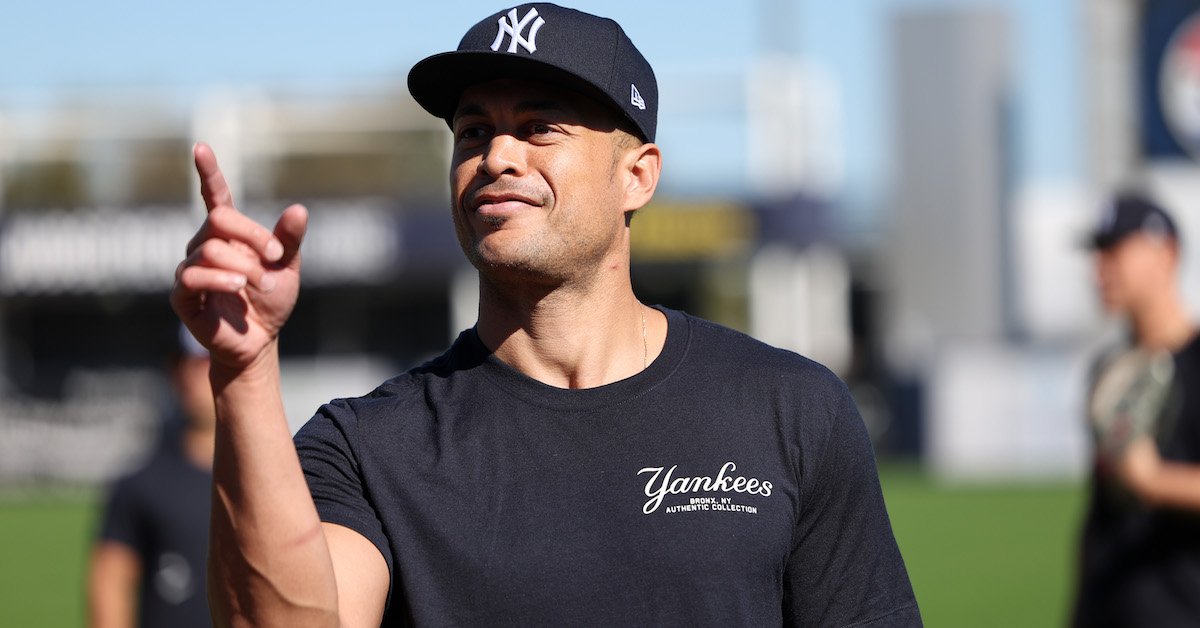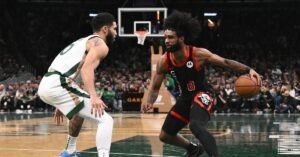[ad_1]

Following a career-worst season and some stinging public criticism from Yankees general manager Brian Cashman, Giancarlo Stanton is making some changes. Earlier this week, the oft-injured 34-year-old slugger reported to spring training looking significantly leaner than in the past, and on Wednesday provided the public with the first glimpse of his reworked swing. Sure, this all fits into the realm of spring training clichés, and batting practice cuts won’t tell us whether the changes can reverse his decline or improve his chances of staying healthy, but a rebound would certainly be welcome as the Yankees attempt to recover from their worst record in 31 years.
Amid a season in which so many key Yankees wound up sidelined by injuries for significant spells, Stanton played in just 101 games, his lowest full-season total since 2019, when he was limited to 19 games by left biceps and right knee injuries. This time around, he missed 46 days due to a left hamstring strain, the latest in a litany of lower body injuries he’s incurred since the start of 2019:
Giancarlo Stanton’s Injuries as a Yankee
Start
End
Days on IL
Injury
4/1/19
6/18/19
78
Left biceps strain
6/26/19
9/18/19
84
Right knee sprain (PCL)
10/13/19
10/18/19
5*
Right quadriceps strain
8/9/20
9/15/20
37
Left hamstring strain
5/14/21
5/28/21
14
Left quad strain
5/25/22
6/4/22
10
Right ankle inflammation
7/24/22
8/25/22
32
Left Achilles tendonitis
4/16/23
6/1/23
46
Left hamstring strain
SOURCE: Baseball Prospectus
* = no injured list; missed time during American League Championship Series.
That’s 301 days on the injured list, not including his missing three games in the 2019 ALCS against the Astros. Meanwhile, Stanton has played 391 regular season games, which prorates to an average of 89 over a 162-game season.
It was with that frustrating series of absences in mind that Cashman vented during a media session at the GM meetings in Arizona last November, “I’m not going to tell you he’s gonna play every game next year because he’s not. He’s gonna wind up getting hurt again, more likely than not, because it seems to be part of his game.” To be fair, Cashman immediately added, “But I know that when he’s right and healthy – other than this past year – the guy’s a great hitter and has been for a long time.”
Stanton refrained from public comment at the time, letting agent Joel Wolfe trade volleys with the GM, who went into damage control mode. “I value Giancarlo Stanton as a player,” he told reporters. “Without a doubt, he’s one of the big drivers when we do win. He’s one of the few players you bring to New York that hasn’t backed down, that has handled himself in a professional manner through thick and thin.” The GM additionally spoke with both player and agent to clear the air, and since then, both Cashman and Stanton have kept the substance of their discussion private. “He knows my reaction to that,” said the latter at the Yankees’ spring training complex on Monday.
Until 2023, Stanton’s absences were mitigated at least somewhat by his productivity. He hit .248/.338/.493 for a 130 wRC+ from 2019–22, including .273/.354/.516 (138 wRC+) in his 139-game ’21 campaign, his healthiest one of that stretch. He made the AL All-Star team in 2022, but his ugly final line (.211/.297/.462, 116 wRC+) concealed a drastic split: He hit .285/.339/.523 (142 wRC+) through May 24, his last day before landing on the IL due to right ankle inflammation, but just .166/.272/.425 thereafter, and to get to an even 100 wRC+ for that stretch required hitting home runs in his final three games. That sorry batting line looks a lot like last year’s one (.191/.275/.420), though with rising scoring levels, the latter was good for just an 89 wRC+ and -0.8 WAR. Since that ankle-related IL stint, he owns a 93 wRC+ and -0.6 WAR in 699 PA. It ain’t great.
As ever, Stanton struck out a lot, but that wasn’t his primary problem. In terms of overall strikeout rate, his 29.9% was down 0.4 points from 2022, and dead even with ’18. His 34.1% whiff rate was right at his Statcast-era average, down 2.4 points from 2022, and down 0.3 points from ’18. His 13.7% swinging strike rate and his 29.4% chase rate were both similarly below 2018, ’22, and his career marks.
Likewise, Stanton continued to put a charge in the ball when he connected, if not quite as hard as in recent years (I’ve omitted 2019 and ’20 due to their small samples):
Giancarlo Stanton Statcast Profile
Season
EV
Percentile
Barrel%
Percentile
Hard-Hit%
Percentile
2018
93.7
99
8.9%
97
50.8%
97
2021
95.1
99
9.7%
91
56.3%
100
2022
95.0
99
11.3%
98
52.3%
98
2023
93.3
96
9.4%
94
48.4%
86
Not all contact is created equal, of course. Stanton pulled the ball 41.1% of the time in 2023, up from 36.5% in ’22 and his highest full-season rate since ’17, when he was still a Marlin. In general, pulled fly balls tend to be the most productive, while opposite field groundballs tend to be more productive than pulled ones even after the banning of infield shifts. What we see with Stanton is that his results on pulled groundballs — which used to be quite good, because he hit them so hard — have deteriorated drastically, as have his results on pulled fly balls:
Giancarlo Stanton Groundballs and Fly Balls to Pull Side
Season
Pull GB%
EV
LA
Hard-Hit%
AVG
Lg AVG
SLG
Lg SLG
wOBA
Lg wOBA
2018
20.0%
93.8
-12.4
49.4
.337
.243
.398
.286
.319
.230
2021
20.2%
94.4
-13.1
58.3
.236
.218
.278
.259
.223
.206
2022
18.6%
96.8
-11.8
57.1
.184
.220
.184
.259
.162
.209
2023
21.4%
91.3
-19.8
49.1
.113
.220
.113
.260
.100
.209
2018
5.5%
100.4
35.0
39.1
.478
.490
1.826
1.743
.937
.885
2021
4.8%
100.7
36.9
47.1
.438
.485
1.750
1.716
.826
.896
2022
6.1%
99.6
31.8
68.8
.667
.495
2.467
1.775
1.221
.899
2023
7.7%
99.9
37.2
36.8
.316
.493
1.263
1.797
.633
.912
SOURCE: Baseball Savant
Because xBA, xSLG, and xwOBA don’t account for spray angle, I’ve instead used the annual league-wide averages for right-handed hitters where I’d usually put those figures. You can see that Stanton was way below those averages last year despite exit velos about 5 mph above the league-wide averages. His launch angles were particularly extreme, given that righties averaged -12.0 degrees on pulled grounders and 34.7 degrees on pulled fly balls. His 37.2-degree average on the latter was so high as to be unproductive; he was over 500 points short of the league average slugging percentage on fly balls. I couldn’t fit it into the table, but the estimated average distance on his pulled fly balls in 2023 was 344 feet, a full 20 feet shorter than his average from the year before; he averaged 356 feet in 2018 and 348 in ’21.
Some of the missing production probably owes to Stanton’s speed, or lack of it. His sprint speed fell from the 69th percentile in 2018 to the 13th percentile by ’21, and was down to the fourth percentile last year. It’s likely that some of this is intentional — his not running hard at times is a way to prevent injuries or to avoid turning minor aches into major problems — but it’s no doubt costing him hits here and there, contributing to his shortfalls in batting average relative to xBA. In fact, a quick look at his player page shows that his rate of infield hits per groundball (IFH% on his player page) has fallen from 12.8% in 2018 to 4.4% in ’21, 4.1% in ’22 and 2.8% last year.
Meanwhile, Stanton got under a lot more balls than usual, regardless of direction, leading to a higher percentage of harmless popups and flies. His 26.6% Under rate was his highest of the Statcast era, well above his 19.7% in 2022; he hadn’t been above 22% since ’16. He went 6-for-66 on those balls in 2023, which was actually better than his 2-for-52 in ’22 or his 4-for-70 in ’21; the problem was that those balls occupied a larger share of his contact.
Though he still slugged .533 against four-seamers and .516 against sinkers, Stanton was much less productive against fastballs of both types than in the past. He struggled with sliders, as he usually does, and was utterly helpless against curveballs, which was comparatively new. In 2018, he hit .233 and slugged .517 against curves, and even in ’22, he was at .222 AVG/.389 SLG; last year, he plummeted to .115 AVG/.269 SLG. His heat maps show that he has serious holes in his swing. Here’s a comparison between his heat maps for barreled balls against fastballs (the top pair) and breaking balls (the bottom pair); 2018 is on the left and ’23 on the right. Note how much smaller the coverage of the latter is — he didn’t barrel a single ball against pitches outside those areas — and how there is much less red.

Here’s a look at the progression of Stanton’s overall xwOBAs by Gameday zone:

Check out the sequence in the lower right corner of the strike zone. Within this timespan, Stanton’s xwOBAs in that cell have dropped from .287 to .252 to .207 to .129 (see here to zoom in on the numbers). Meanwhile, all of the red has disappeared from the upper and outer thirds of the zone. As Alex Chamberlain wrote last week, that upper third is particularly important when it comes to producing pulled fly balls, so it doesn’t help that Stanton’s whiff rate in that part of the zone has climbed from 23.1% in 2018 to a decimal or two on either side of 30% in the last two seasons — more than double the league-wide rate.
Particularly in light of the data, I’m hardly the first to wonder if Stanton’s series of lower body injuries has compromised his flexibility, contributing to those open holes in his swing. Indeed, in September at Pinstripe Alley, Malachi Hayes built on FanGraphs contributor Esteban Rivera’s visual breakdown of some mechanical issues Stanton was having, pointing out the slugger’s increased difficulty with low breaking balls and the way pitchers were going even lower against him:
Sliders and changeups, making up about a third of the pitches he sees, are crossing the plate a little less than two inches lower and a little bit farther away than they have over the last few years. It sounds like a small change, but the difference shows up in heat maps — especially against right-handed pitchers — and it seems increasingly clear that he just can’t go down and get those pitches like he used to.
Stanton, whose work ethic and conditioning have never been in doubt within the organization, told reporters he spent the offseason focusing on mobility and on changing his swing. Improved mobility should help him find time in an outfield mix that will include Alex Verdugo in left, Aaron Judge in center, and Juan Soto in right. Light-hitting Trent Grisham can help in center, and while that could mean Judge spending time in left field, as manager Aaron Boone suggested last month, it’s probably going to mean a lot of DH duty for No. 99 as well, given his own injury history. The situation will only become more crowded once Jasson Domínguez returns from the Tommy John surgery he had in September. Unless Stanton can play the outfield — more likely right field, with Soto slotting in left — he stands to lose playing time. He played just 33 games in the outfield last year, and 38 the year before, and the results were quite poor (a combined -7 DRS, -4 RAA, and -0.8 UZR in 567 innings for the two seasons). More mobility certainly couldn’t hurt.
As for the promised changes, here’s a glimpse of the 6-foot-4 Stanton (listed at 245 pounds but looking lighter) appearing kind of skinny next to the 6-foot-7, 282-pound Judge, via Newsday’s Erik Boland:
Judge and Stanton after playing catch pic.twitter.com/kxZUjVx2sE
— Erik Boland (@eboland11) February 19, 2024
Here’s a side-by-side comparison of Stanton’s stance, from last season to this year, courtesy of The Athletic’s Chris Kirschner:
Side by side look of Giancarlo Stanton’s stance from videos I shot. Left is today. Right is last year.
We will see what it looks like with the game angle camera.
Stanton said he was making some changes to his swing pic.twitter.com/cs3Tmmp9m8
— Chris Kirschner (@ChrisKirschner) February 21, 2024
And here he is taking a BP cut:
Here’s Giancarlo Stanton pic.twitter.com/e9QOSWCgGy
— Chris Kirschner (@ChrisKirschner) February 20, 2024
Stanton is more upright, with his back leg closer to the plate than before, but at this level of intensity and the limited number of angles, it’s tough to say more than that. Given that it’s February, his changes — and those of everybody else who reported to camp talking about swing tweaks, new pitches, and improved training regimens — should be considered a work in progress. With the addition of Soto, there’s a bit less pressure on Stanton to be one of the lineup’s primary producers, but the Yankees can’t justify playing him if he remans below replacement level. We’ll see soon enough whether he can return to being close to the dangerous hitter he used to be.
[ad_2]
Source link


